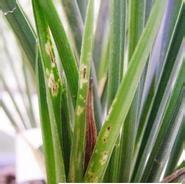Infection cycle of orchid virus disease

Viruses are parasites in living cells. It does not have the ability to destroy plant cell walls, nor can it carry out saprophytic life on dead cells and tissues as parasitic transition like other parasitic parasites. Therefore, when the virus invades the orchid strain, a slight wound must be required. This kind of wound can not only cause damage to the cell wall, but also not lead to a large number of cell death. In this way, the virus can immediately come into direct contact with living cells and further proliferate and expand in the cells. During orchid cultivation, such minor wounds may come from abrasions on healthy and diseased plants when they come into contact with each other, or stab wounds or artificial pruning and mechanical injuries of insects, especially insects with piercing mouthparts. After entering the living cell, the virus can only expand passively by relying on the transport mechanism of the host. When it is in parenchyma, it slowly expands from one cell to another. But once it reaches the phloem, it begins to move rapidly with the liquid flow of the plant. It is estimated that the incubation period of Jian Cymbidium mosaic virus infection host is about 30 days in summer of 30 ℃, 20 days in winter of 15 ℃, the in vitro survival time is 60 ℃ 70 days, the lethal temperature is 60-80 ℃, the incubation period of infection parasitism of orchid ringspot virus is about one week, the in vitro survival time is more than 763 days, and the lethal temperature is more than 93 ℃. It has not been reported that the main drivers of fungal and bacterial transmission-air currents, currents, and Rain Water-play an role in the spread of the virus. Most of them rely on insects as vectors. Occasionally, it can be spread by contact and friction of diseased plants. The insects that transmit the virus are mainly species with piercing and sucking mouthparts, among which aphids and leafhoppers are particularly important. And scale insects are also questionable. Some people think that nematodes can also spread orchid virus. The virus can maintain its vitality in the insect for a long time. As long as the insect feeds on the susceptible plant, it can spread the virus for a long time, even for a lifetime. The virus can proliferate continuously in the insect host, and even pass on to its offspring as the insect propagates. The virus mainly exists in the salivary glands of insects and infects the orchid strain when the insect enters the plant with saliva. In the process of cultivation, due to ramet, pruning roots and leaves, making pruning tools carry virus and spreading each other is also an important way for orchid virus disease to occur. There is no doubt that the source of viral disease is living host plants and insects. Once the orchid strain is infected with the virus, the virus will survive in the plant for a long time, unless the orchid strain dies or is artificially destroyed.
- Prev

Orchid virus diseases General characteristics
Orchid virus disease is the number one killer affecting orchid cultivation, orchid lovers all talk about virus and color change. Orchid virus disease is everywhere. It infects not only cultivated orchids but also wild orchids grown in nature. Once infected by the virus, orchids can be appreciated and cultivated...
- Next

Several common orchid viruses and their transmission routes
1. Common orchid virus 1. Cymbidium mosaic virus CymbidiumMosaicVirus referred to as CyMV (1) Cymbidium mosaic virus infected orchid plants often have a tendency to produce gangrene, such as black gangrene spots, gangrene stripes and so on. In addition to the gangrene in the leaves and stems of susceptible plants, the flowers are also.
Related
- Fuxing push coffee new agricultural production and marketing class: lack of small-scale processing plants
- Jujube rice field leisure farm deep ploughing Yilan for five years to create a space for organic food and play
- Nongyu Farm-A trial of organic papaya for brave women with advanced technology
- Four points for attention in the prevention and control of diseases and insect pests of edible fungi
- How to add nutrient solution to Edible Fungi
- Is there any good way to control edible fungus mites?
- Open Inoculation Technology of Edible Fungi
- Is there any clever way to use fertilizer for edible fungus in winter?
- What agents are used to kill the pathogens of edible fungi in the mushroom shed?
- Rapid drying of Edible Fungi

